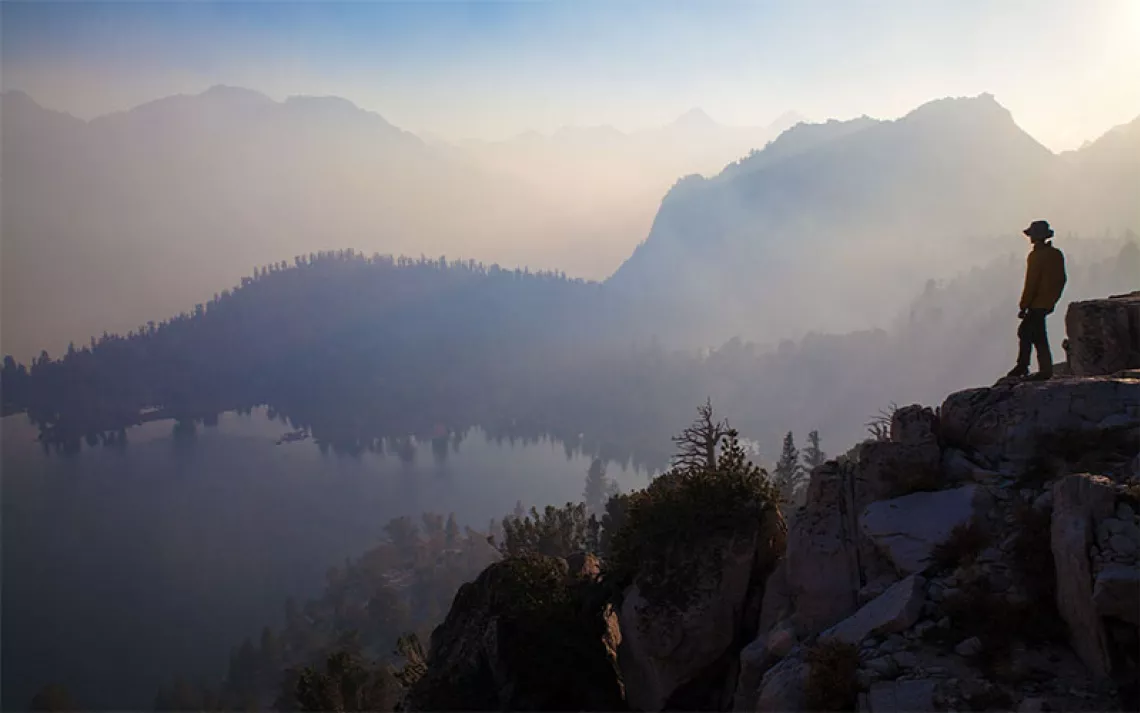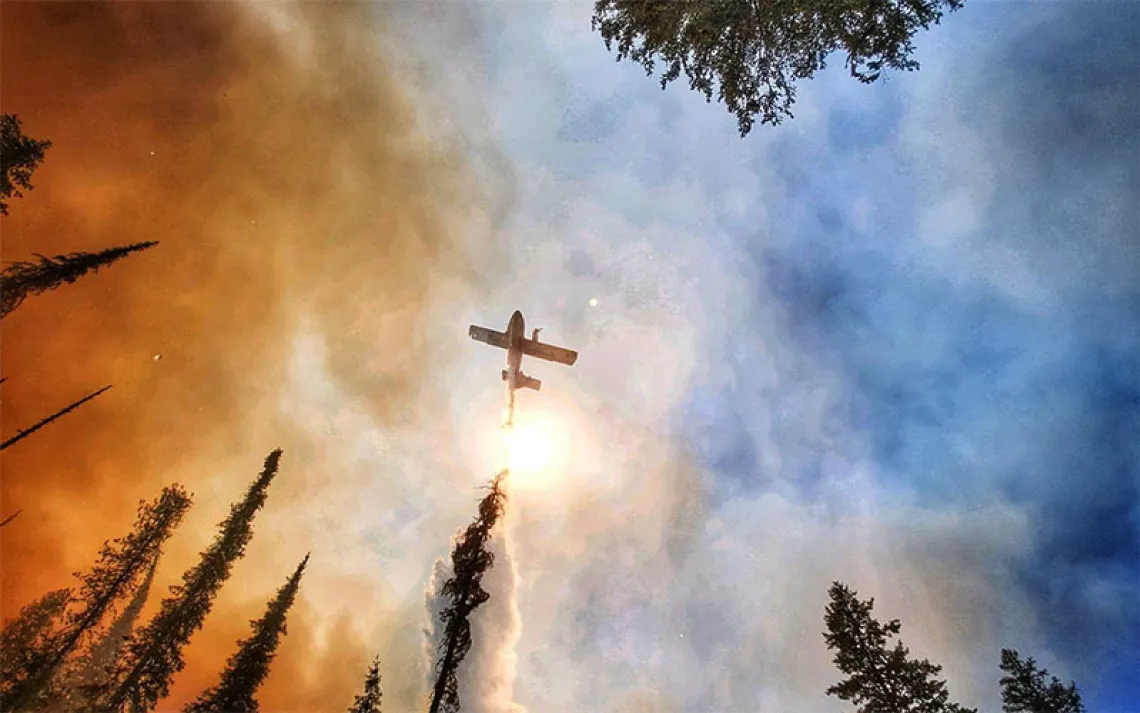The View Is Made by Walking
A backpacker goes to the Grand Canyon, savoring the journey just as much as the destination

Photo by franckreporter/Getty
To the north, at the far edge of sight, there's a giant wall of rock stretching east to west across the horizon, a ridge erupting out of the otherwise unbroken sweep of ponderosa pine forest. From my vantage, it looks like an impenetrable cliff. But I've got a map, so I know better. What I'm seeing is the far side of a giant, miles-wide hole in the earth. The wall ahead is the North Rim of the Grand Canyon, and the hump of stone I can discern in the midst of the cliff face is Vishnu Temple, one of the canyon's most dramatic formations.
Every year, more than 4 million people visit Grand Canyon National Park. A vast majority come to the South Rim by automobile. They pass through the gateway community of Tusayan with its strip malls and pizza joints, wait in a long line of cars to pay at the entrance gate, and finally arrive at a packed viewpoint where buses clatter past.
My companions and I have chosen a less traveled route. We're walking to the canyon. More precisely, we're backpacking a two-day, 19-mile portion of the Arizona Trail. The AZT—which stretches 800 miles from Mexico to Utah—was declared a national scenic trail in 2009 and was finally completed in 2011 (thanks to die-hard volunteers). Among AZT enthusiasts, this section is considered one of the most spectacular: a mix of high-desert plains, vast ponderosa stands, epic views of the Navajo lands, and of course the payoff of the Grand Canyon.
We started our trek at Moqui Station, a former stop on the stagecoach route that, in the 19th century, took tourists from Flagstaff to the canyon. Today, nothing remains of the station except a weathered historic marker and a bone-dry well surrounded by dry-stacked stones.
It doesn't take us long—a mile or so and a slight elevation climb—before the scrunched-up piñon and juniper give way to towers of ponderosa. The Kaibab National Forest sweeps from south of the canyon to the vast plateau north of the gorge and encompasses one of the largest ponderosa pine forests in the world. (Kaibab is the Paiute word for the Grand Canyon, roughly translated as "mountain lying down.")
This is still a wild land—we see lots of elk sign and pass a small herd of horses—but it doesn't enjoy the protections of a legal wilderness or a national park. Less than 20 miles away, uranium-mining explorations are underway. Which is one of the reasons we came to this landscape. Conservation organizations, including the Sierra Club, have campaigned for years for these lands to be designated a national monument, to ensure that the greater Grand Canyon watershed is protected just like the gorge itself. We're here to see what this hoped-for national monument looks and feels like. (President Barack Obama did not declare a Greater Grand Canyon Heritage National Monument before the end of his term, a major disappointment for conservationists.)
The Southwest's winter rains lasted through the spring of 2016, and, more than anything, the Kaibab feels lush. The forest floor is carpeted with grass and sprinkled with wildflowers: purple lupine, clumps of pink paintbrush, yellow cinquefoil, and puffs of owl's clover. Most of my trail companions have never been in the Grand Canyon State before, and they're shocked not to be hiking through saguaros and ocotillos. But the green is deceptive. This is still essentially a desert. If we had been trusting to find water, we would have been harshly disappointed. The stock tank at Mile 9, the only possible source of water, is a mud puddle. We've planned ahead, though, and a water cache is there waiting for us.
On day two, we begin to see the canyon. As we trace the lip of an escarpment called the Coconino Rim, we keep spotting it—glimpses of something big ahead, peeping through the columns of ponderosa. This is scenery as striptease. The hints of view only increase the longing for the object of our interest.
The sun is in the west when we reach our destination—a former U.S. Forest Service fire lookout called Grandview Tower. We rush up the switchback iron staircase, and there it is: the vast canyon just a couple of miles to the north, spread out before us in its iconic glory.
We're all excited to have reached the canyon. But the big view is only part of the pleasure. The time on the Arizona Trail wasn't merely prelude. It was exploration itself—and surely those trail miles must influence this experience now. If, as the old poem goes, the path is made by walking, then isn't the destination made by the mode of arrival? We didn't speed here in a car. We came leisurely, one foot after the other. We earned our wonder the old-fashioned way, with sweat equity.
Like all visitors to the Grand Canyon, we gawk at the sight and marvel at what we know of its epochs-long making. But I imagine our experience is different from those in the rim-side parking lots. After we've walked miles in the woods, the canyon isn't just spectacle. It's something closer to revelation.

Map by Steve Stankiewicz
- Where: Arizona Trail to the South Rim
- Getting There: This is a one-way route, so have someone drop you off at Moqui Station and leave a vehicle at Grandview Tower, or use two cars in a shuttle system.
- When to Visit: October to May. Summer can be brutally hot. In the spring you'll be hiking amid wildflowers.
- Permits: Most sections do not require a backpacking permit.
- Survival Tip: Drink lots of water—at least one gallon per person per day—and be prepared to bring your own. You can pack it, but it's heavy (eight pounds a gallon). Better to arrange a water cache like the one our support crew left at Russell Tank.
- Pro Tip: A campfire offers great companionship, but this landscape is a tinderbox most of the year. Stick with your campstove.
- Must-See: The creaky, old Grandview Tower will test acrophobes, but make the climb anyway. The vista is rare: the sweep of forest and the outcropping of Red Butte to the south, the Grand Canyon to the north, and the Navajo Nation to the east.
- Unexpected Fun: Lying on our backs tracking the satellites streaking among the stars. We counted 10 in 30 minutes.
- More: aztrail.org
This article has been modified since its original posting.
Take a Sierra Club Outings trip to the Grand Canyon. For details, see sierraclub.org/adventure-travel.
 The Magazine of The Sierra Club
The Magazine of The Sierra Club



